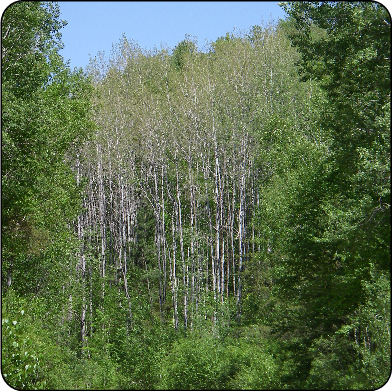Large aspen tortrix
Information about large aspen tortrix (Choristoneura conflictana), a forest defoliating insect found in Ontario.
Overview
- Large aspen tortrix is second to forest tent caterpillar as the biggest defoliator of aspen.
- Outbreaks are short lived (2 to 3 years), as this native pest is susceptible to a large number of natural parasites, predators and disease.
- This early season defoliator is found in the range of trembling aspen in Ontario.
- Outbreaks of large aspen tortrix often precede those of forest tent caterpillar.
Host species
Host species of large aspen tortrix are trembling aspen (Populus tremuloides), white birch (Betula papyrifera), willow (Salix) and alder (Alnus). It can also be found on balsam poplar (Populus balsamifera) and chokecherry (Prunus virginiana).
Species identification and life cycle
- In early May, larvae crawl up the base of the tree and mine host buds before the buds open.
- Larvae tie, roll and curl expanding leaves.
- Mid-June pupation occurs in tied leaves.
- Adult moths hatch and take flight late June to early August.
- Moths are medium-sized with brown grey forewings and smoky grey hind wings, wingspan of 25-35 millimetres; females are larger than males.
- Eggs (50-450) are laid in August in a cluster on top of the leaves.
- Small translucent green larvae emerge and briefly feed on tied leaves.
- Larvae drop to base of tree in a silken cover in late August.
- Young larvae are yellowish to green.
- Mature larvae are dark green to black (20mm) with brown head and legs.

Symptoms and damage
- Affected trees will often have thin crowns with only a few leaves left on which larvae pupate.
- Black pupal cases are produced in rolled leaves; eggs are seen in clusters on leaves.
- Damage can delay leaf flush in early summer and reduce incremental growth.

Control measures
Chemical control is not recommended, primarily because of the effective action of natural parasites, predators and disease organisms associated with large aspen tortrix.
Updated: July 28, 2022
Published: July 18, 2014